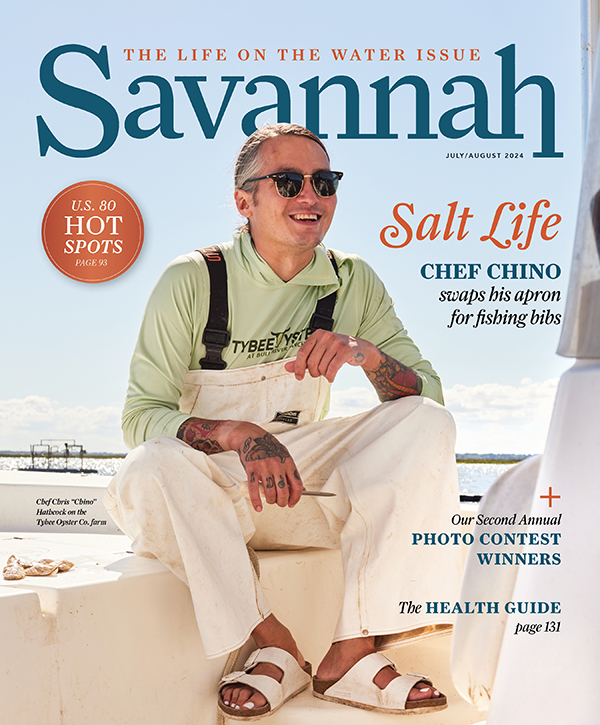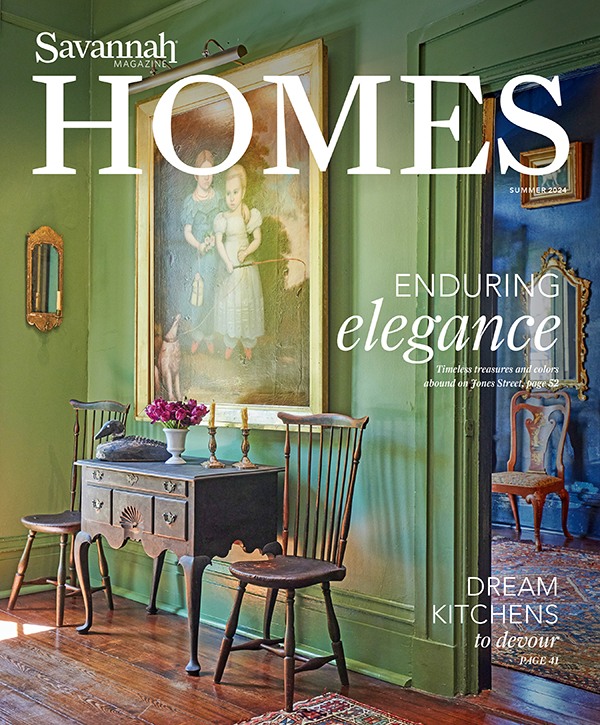As one of the most haunted cities in the country, Savannah is the ideal playground for paranormal investigators. A rookie ghost hunter takes you on her chilling chase.
Photography by MICHAEL HRIZUK
LET ME BEGIN by saying I believe in ghosts.
I have not seen a ghost, but I’ve lived in three homes that felt haunted, including my childhood one where my mother experienced sightings and another where my cat spent her days hissing at the walls. But that’s as far as my ghost experiences have gone: a creepy feeling that makes me cover my eyes at night when I sleep.
I have no interest in seeing a ghost; the thought of it actually terrifies me, but curiosity got the best of me. That, and the enthusiasm and encouragement of the Paranormal Society of Savannah.

I first meet Patrick Welsh, lead investigator and founder of the Paranormal Society of Savannah, at a spooky warehouse that’s the permanent home to the Alee Shriners’ annual haunted house. Welsh has been a Shriner for nearly 25 years and earned the moniker The Savannah Scaremaster for his part in helping create and manage the haunted house over the years. (Although you might also recognize him as the belly-dancing Shriner who performs in the St. Patrick’s Day parade each year).
He’s not what I expected. For one, there’s nothing scary or creepy about Welsh. He’s not a demon-worshiping, paranormal zealot who spends his days alone in his parents’ basement hovering over a Ouija board. He’s just a nice guy in his late 40s who works at the Eichholz Law Firm, is scared to death of needles and snakes and really excited about ghosts. And only once did he ever touch a Ouija board.

“We tell people that we are not professionals,” Welsh says. “The people on TV aren’t even professionals. If someone tells you they are a professional paranormal investigator, run.”
Welsh doesn’t pretend to have special access to the spiritual realm, nor is he on a mission to convince nonbelievers that ghosts are real. He and his growing team of investigators aim to capture evidence of ghostly activity on various equipment, which can range from EVP digital sound recorders and expensive EMF meters, to simple images and voices your cell phone picks up that you might not otherwise see or hear. They also offer Ghost Investigating 101 and 102 classes and a free ghost-busting service, where they investigate and cleanse a house of any evil spirit that may be causing harm to the residence. (Although donations to cover travel expenses are appreciated.)

A few minutes later, we’re joined by Sarah Nesmith Cook, an investigator and the team’s case manager who also happens to be Welsh’s childhood friend. She’s equally as welcoming as she gives me an overview of the equipment and how it’s used, including the phone apps they prefer to use, like GhostTube SLS and Ghost Radar. Cook places one piece of equipment, a REM-Pod-EMT, on a nearby table where they’ve detected activity in the past. The REM-Pod is about the size of a roll of toilet paper, with a small antenna and four colored lights on top. When it detects sudden energy disturbances and temperature fluctuations, it provides audible and visual alerts.
I soak up Cook and Welsh’s countless creepy stories of the ghost encounters they’ve experienced both growing up and while conducting more than 160 investigations since forming the group in 2020. This includes evidence of a human figure dangling from what is known as “The Hanging Tree” in Bluffton, South Carolina, and a recording of drums, voices and figures captured at the site of the Long Canes Massacre near Abbeville, South Carolina. (You can find video evidence of both on the PSS Facebook page.)

“We make sure we document everything, video as much as we can, do the research, learn the history of the location and try to back it up with facts,” Welsh says. “But it’s kind of like fishing. You don’t catch something every time you go, but you keep doing it because you enjoy it.”
When I inquire about the most terrifying ghost encounter Welsh has experienced, the REM-Pod suddenly comes to life, setting off the red light and emitting a high-pitched sound that lasts about 15 seconds. He tells me it happened at a house on Savannah’s southside, owned by the Rancourt family, which is also the subject of the film “A Savannah Haunting,” to be released internationally on Oct. 28. Welsh and his team participated in a later-to-be-released documentary film in which they helped verify the authenticity of the haunted house.

The REM-Pod becomes even more active as they tell me about the evil spirit that haunts the warehouse we’re in. I ask Cook and Welsh if we can try communicating with it, and they’re all in. Cook poses a series of questions, such as, “Is there anybody here with us?” and “Can you tell us your name?” When she asks, “Do you want us to leave?” Welsh’s Ghost Radar app, which detects words below the range of human hearing, reads “Angel.” Cook tries to follow that lead with more specific questions. When she asks, “Can you tell me how long you’ve been here?” the REM-Pod alerts about 20 beeps in rapid succession. As the questioning continues, Welsh’s app picks up the names “Martin” and “Kyle,” and Sarah asks if those two are here with us before the activity dies out.
“If someone tells you they are a professional paranormal investigator, run.” — Patrick Welsh, lead investigator and founder, Paranormal Society of Savannah
Later, while listening to my digital recording of our conversation, I catch a faint disembodied female voice saying “There are only two” in response to Sarah’s last question.
So when Cook and Welsh invite me on an actual paranormal investigation a few days later at one of Savannah’s most haunted locations, I eagerly accept.
It’s late July, and my clothes and hair are dampened with sweat before I even enter the Graveface Museum, where our investigation will take place and air conditioning seems to be nonexistent.

In some preliminary research, I determine that the museum might be more terrifying than any ghosts that haunt it. Located in a former abandoned space on Lower Factors Walk, Graveface is a place of eerie oddities. It’s overpopulated with horror pinball machines, taxidermy, serial killer memorabilia, and — perhaps most terrifying — a worn-out, life-size Ronald McDonald doll with a sign reading “I don’t like to be touched.” In fact, Cook and Welsh brought us to this location because they knew we’d be guaranteed some ghostly encounters. We’re also joined by PSS core investigators, David Guruel, Walter Finely, Pat “Papa Smurf” Welsh Sr. and Jay Chughtai, and Savannah magazine Art Director Rebecca Hrizuk and her husband, Michael, the photographer who’s documenting the event.
We begin in what is called “The Serial Killer Room.”
We ascend the steps to the windowless room, careful not to brush against Ronald McDonald. As soon as I enter the room, my chest is tight, like I’m at high altitude and can’t take a full breath. It’s not fear; it’s something else.
“But it’s kind of like fishing. You don’t catch something every time you go, but you keep doing it because you enjoy it.” – Patrick Welsh, lead investigator
“What are you feeling?” Welsh asks the three first-timers. We all describe the same sensation.
“Yeah,” Patrick nods knowingly.
The Serial Killer Room is small, like a bedroom. The walls are covered with tokens and memorabilia belonging to serial killers of the past, like John Wayne Gacy, Charles Manson, the BTK Killer and Ted Bundy. Many of the items were given to owner Ryan Graveface from family members of the killers, like Gacy’s sister who gave Graveface her brother’s paintings and his prison log.
Michael Hrizuk attempts to capture some images but when he pushes the shutter release, nothing happens.
“What the … ? I think my camera just broke.”

Hrizuk removes the long lens and examines the shutter it protects, which looks as if a finger poked it, damaging the shutter. “What the hell?” he says, clearly as rattled and freaked out as the rest of us, especially considering the camera worked perfectly downstairs.
Hrizuk pulls out another camera, and we nervously begin the investigation. I volunteer to participate in what’s called the Estes Method. I’m wearing earbuds hooked to a Spirit Box that scans for radio frequencies. I’m instructed to repeat any words I catch amongst the white noise or indicate if I feel anything. I’m blindfolded, and noise-canceling headphones are placed over earbuds to ensure I can’t be influenced by seeing or hearing the others in the room. Once in place, the Paranormal Society team asks questions directed to the spirits, much like we did in the warehouse days earlier.
I’m disappointed to reveal that I don’t hear or feel anything, though the EMF meter and apps do pick up activity in the room. I’m also gripping a St. Christopher pendant that I don’t mention to anyone, which has now become an official talisman. Our photographer has better luck. Although Hrizuk doesn’t catch any voices, he tells us that he feels a coldness on his left side, that’s growing more intense. We can hear in his voice that he’s unnerved. The Ghost Radar app catches the word “Connected.”
Spooked, Michael abruptly removes the equipment.
“It’s not a breeze. I can still feel it. Even my leg is cold,” he explains, breathlessly. “It just got colder and colder and colder and colder.”
I touch his left side and I can feel the chill of his body regardless of the room’s stifling heat.

We have a number of paranormal experiences throughout the evening, but I take comfort in my secret St. Christopher, and in the friendly PSS investigators who seem just as excited and scared as I am.
Welsh concedes that he can’t scientifically prove that ghosts exist. For one, the paranormal activity doesn’t respond in a consistent, measurable way. Sometimes it’s there, and yet another time under the same exact circumstances it might not be. Could it be our imaginations running wild, unusual electromagnet fields or the power of persuasion? Welsh’s team goes to great lengths to rule out such influences and has even been able to debunk a haunting as being related to a hidden electrical box on the fritz. But look, there are a bunch of things science can theorize about but can’t (yet?) explain, including why yawning is “contagious” or why we dream. Is there life in some other corner of the galaxy? Will Amazon take over the world? We don’t know, but the possibilities seem endless. And playing around in the realm of possibilities is pretty darn fun — and frightening — with these paranormal investigators.
HAUNTED GROUNDS COFFEE
The Paranormal Society of Savannah is preparing to open Haunted Grounds Coffee (248 Butler Ave.), a coffee shop that will also serve as the society’s official headquarters. In addition to enjoying typical café fare, patrons can get a taste of paranormal investigations through classes and more. Follow facebook.com/savannahparanormalinvestigators for updates.
ALEE HAUNTED HOUSE
Experience the Alee Shriners’ haunted house on Fridays and Saturdays Sept. 30 – Oct. 31 at 100 Eisenburg Drive. For more information on pricing and hours, go to aleeshriners.org.



